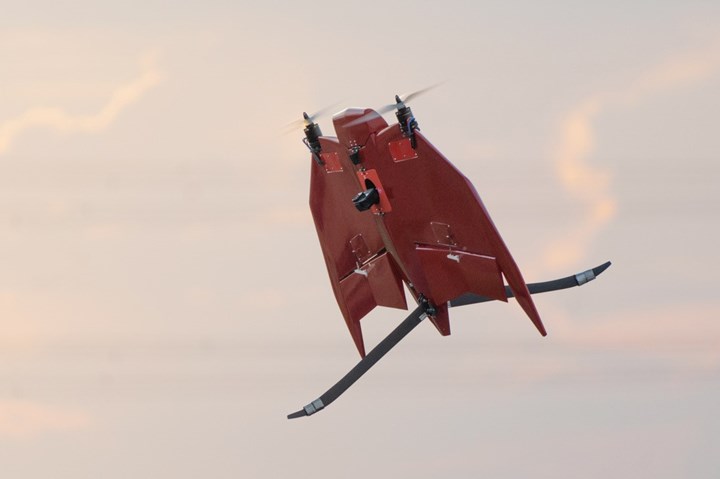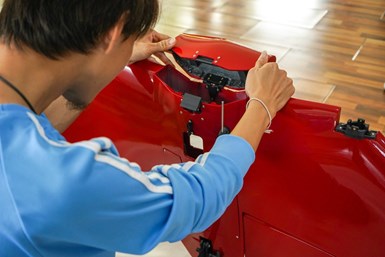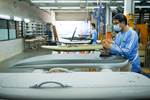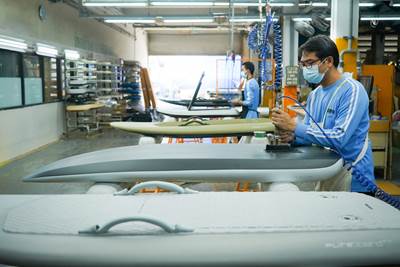Cobra supports new production concept for composites-intensive VETAL tailsitter drone
Cost-effective composite tooling and a scaled-up production line target durability, production rate and price parameters for the VETAL’s carbon fiber flying wing airframe.

All photo credit: Cobra International, HG Robotics
Cobra International (Chonburi, Thailand) has expanded its development and manufacturing partnership with Thai unmanned aerial vehicle (UAV) producer (Bangkok). In this latest collaboration, Cobra has supported HG Robotics with the development of an entirely new production concept for the carbon fiber composite flying wing of the “VETAL” vertical take-off and landing (VTOL) drone.
VETAL is a twin rotor, tailsitting drone that HG Robotics has recently launched for large-scale agricultural surveys, as well as general surveillance monitoring. Cobra reports that it has been working with HG Robotics since 2018 to design and produce its composite components.
Having developed VETAL platform’s initial flying shape, HG Robotics had initially produced the first flying prototypes using a more traditional UAV construction technique of thin composite skins, with ribs and frames supporting the hollow structure. However, although these early aircraft performed well in flight, there were concerns that the construction approach used would not be able to meet all the project requirements relating to durability, production rate and price.
Drawing from its decades of experience with close-tolerance molding of EPS foam-cored sandwich components for the watersports market, Cobra proposed a hybrid solution, combining both hollow and cored sections, for the flying wing. The main body of the aircraft comprises a PVC foam sandwich shell with a low-density EPS foam rib which, combined with a fully foam cored tail structure, is said to deliver a complete airframe fractionally lighter than the customer’s challenging target.
In addition to an impressive cycle time reduction, the new build method also improved the impact resistance and overall durability of the VETAL platform, a key benefit for industrial users who need survey drones with minimum maintenance.

To reduce weight, a combination of carbon fiber stitched biaxial fabrics and unidirectional (UD) reinforcements are used wherever possible, Cobra says, with additional glass fiber-reinforced laminate sections being employed where radio transparency or insulation from metallic parts is required.
The Cobra production engineers have also been able to incorporate glass fiber reinforcements and mounting points for the VETAL’s propulsion system and other ancillary equipment into the molding process, minimizing the additional processing steps in the assembly and finishing stages.
Currently, cost-effective composite tooling has been produced for the first Cobra-built VETAL airframes, enabling a rapid start-up to the series production, while still providing the possibility for incremental design changes before switching to CNC-machined aluminum tooling for high-rate production in the future. With process parameters defined in line with the company’s lean manufacturing principles, Cobra has prepared a production line that can scale up quickly. HG Robotics has also successfully developed an extensive client base for its previous multi-rotor drones and Cobra expects to see considerable demand for the new VETAL platform for larger scale survey applications.
“We are pleased to be strengthening our relationship with HG Robotics and working together on the VETAL project,” says Sila Sertsorn, technical director, Cobra International. “It is a great example of how Cobra can develop durable, reliable and affordable composite components and manufacture on a mass production scale. Our customers are exceptional product designers, and we provide the complimentary skills to incorporate the most efficient composite materials and processes.”
Related Content
Otto Aviation launches Phantom 3500 business jet with all-composite airframe from Leonardo
Promising 60% less fuel burn and 90% less emissions using SAF, the super-laminar flow design with windowless fuselage will be built using RTM in Florida facility with certification slated for 2030.
Read MoreWelding is not bonding
Discussion of the issues in our understanding of thermoplastic composite welded structures and certification of the latest materials and welding technologies for future airframes.
Read MoreFirst Airbus A350 crash confirmed in Haneda
Shortly after touch-down, a JAL A350-900 aircraft recently collided with a De Havilland Canada Dash 8. Exact circumstances are still unknown.
Read MorePlant tour: Airbus, Illescas, Spain
Airbus’ Illescas facility, featuring highly automated composites processes for the A350 lower wing cover and one-piece Section 19 fuselage barrels, works toward production ramp-ups and next-generation aircraft.
Read MoreRead Next
Cobra International supports composite electric hydrofoil board evolution
Cobra continues to deliver materials, production process support, as well as manufacture Fliteboard’s carbon fiber Fliteboard Series 2 surfboards.
Read MoreCutting 100 pounds, certification time for the X-59 nose cone
Swift Engineering used HyperX software to remove 100 pounds from 38-foot graphite/epoxy cored nose cone for X-59 supersonic aircraft.
Read MoreNext-gen fan blades: Hybrid twin RTM, printed sensors, laser shock disassembly
MORPHO project demonstrates blade with 20% faster RTM cure cycle, uses AI-based monitoring for improved maintenance/life cycle management and proves laser shock disassembly for recycling.
Read More












